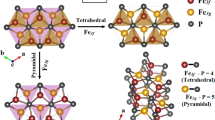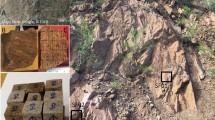Abstract
ROCKS containing 1 or 2 per cent of magnetic minerals are so slightly ferromagnetic that reliable measurements of magnetostriction by the direct observation of changes in dimensions would, at best, be extremely difficult. However, an understanding of the magnetostriction of rocks is very desirable on account of the disagreement which has arisen concerning its possible role in palæomagnetism1–4. The purpose of this communication is to report an experiment which shows that the saturation magnetostrictions of rocks are easily measured in terms of stress-induced anisotropy, and that, in the few rocks examined, they have values which would be expected from their known magnetic mineral contents.
This is a preview of subscription content, access via your institution
Access options
Subscribe to this journal
Receive 51 print issues and online access
$199.00 per year
only $3.90 per issue
Buy this article
- Purchase on SpringerLink
- Instant access to full article PDF
Prices may be subject to local taxes which are calculated during checkout
Similar content being viewed by others
References
Graham, J. W., Buddington, A. F., and Balsley, J. R., J. Geophys. Res., 62, 465 (1957).
Graham, J. W., Buddington, A. F., and Balsley, J. R., Nature, 183, 1318 (1959).
Stott, P. M., and Stacey, F. D., Nature, 183, 384 (1959).
Stott, P. M., and Stacey, F. D., J. Geophys. Res. (in the press).
Stacey, F. D., J. Geophys. Res. (in the press).
Lee, E. W., “Rep. on Prog. in Phys.”, 18, 184 (1955).
Stacey, F. D., Austral. J. Phys., 13, 196 (1960).
Author information
Authors and Affiliations
Rights and permissions
About this article
Cite this article
STACEY, F. Stress-induced Magnetic Anisotropy of Rocks. Nature 188, 134–135 (1960). https://doi.org/10.1038/188134a0
Issue date:
DOI: https://doi.org/10.1038/188134a0
This article is cited by
-
Stress Effects on Thermoremanent Magnetization
Nature (1961)
-
Stress Effects on Thermoremanent Magnetization
Nature (1960)



